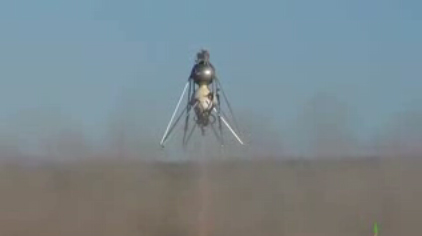Team Armadillo Succeeds in Mock Moon Landing Challenge

A commercial vehicle successfully completed a mock lunarlanding Saturday, qualifying its team to win a $1 million prize offered for NASA?sNorthrop Grumman Lunar Lander Challenge.
The rocket-powered craft, built by ArmadilloAerospace, ascended 50 meters (164 feet) into the air, flew over to land ona simulated rocky lunar surface 50 meters (164 feet) away, and then rose andflew back to land where it started. The flight included a requirement of atleast 180 seconds of flying time.
Armadillo's championcraft, named Scorpius, weighs about 1900 pounds fully fueled. The vehiclemade its flight at the Caddo Mills Airport in Texas, where ArmadilloAerospace?s facilities are based.
Armadillo is the first team to complete these requirements,which comprise Level 2 of the Lunar Lander Challenge. The company won Level 1of the completion in October 2008, snagging a $350,000purse. That achievement required a similar flight, but for half the time - only90 seconds. The minimum flight time for Level 2 iscalculated to simulate a trip between the moon?s surface and lunar orbit.
"Since the Lunar Lander Challenge is quite demanding interms of performance, with a few tweaks our Scorpius vehicle actually has thecapability to travel all the way to space," said John Carmack, head ofArmadillo Aerospace. "We?ll be moving quickly to do higher-altitude tests,and we can go up to about 6000 feet here at our home base in Texas before we?llhave to head to New Mexico where we can really push the envelope. We alreadyhave scientific payloads from universities lined up to fly as well, so thiswill be an exciting next few months for commercial spaceflight."
NASA will award the $1 million prize for Level 2 this year afterall the enteringteams have a chance to compete. Armadillo was the first of three teamsgunning for the title; Masten Space Systems and Unreasonable Rocket are scheduledto make prize attempts soon, before the closing of this year?s competitionwindow on October 31.
"Carmack and the entire Armadillo team made it lookeasy? an overnight success after 4 years of hard work," said Peter Diamandis,Chairman and CEO of the X PRIZE Foundation, which manages the prize on behalfof NASA?s Centennial Challenges program. "Congratulations on two perfectflights. Now we?ll need to see if any other teams attempt the Level 2, NorthropGrumman Lunar Lander Challenge. If no one does, then Armadillo will win $1million in purse cash."
Get the Space.com Newsletter
Breaking space news, the latest updates on rocket launches, skywatching events and more!
The flight represents an achievement not just for Armadillo,but for the whole commercialspaceflight field. With NASA's space shuttle fleet soon to retire, and theagency's goal of returning humans to the moon uncertain in the face of politicaland budget constraints, private companies could play an increasingly importantrole in space exploration.
"Congratulations to Armadillo Aerospace, NASA, and theX PRIZE Foundation for their excellent teamwork in making this week?s LunarLander Challenge milestone possible," said Brett Alexander, President ofthe Commercial Spaceflight Federation. "This competition shows exactly howmuch NASA can benefit from close engagement with the commercial spaceflightsector."
- Video - The 2007 Teams for Lunar Lander Challenge
- Video - 2007 Lunar Lander Challenge Woes
- Future of Flight: Space Tourism, Investment and Technology
Join our Space Forums to keep talking space on the latest missions, night sky and more! And if you have a news tip, correction or comment, let us know at: community@space.com.

Clara Moskowitz is a science and space writer who joined the Space.com team in 2008 and served as Assistant Managing Editor from 2011 to 2013. Clara has a bachelor's degree in astronomy and physics from Wesleyan University, and a graduate certificate in science writing from the University of California, Santa Cruz. She covers everything from astronomy to human spaceflight and once aced a NASTAR suborbital spaceflight training program for space missions. Clara is currently Associate Editor of Scientific American. To see her latest project is, follow Clara on Twitter.









